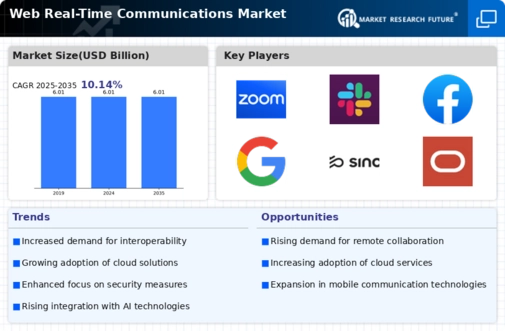Top Industry Leaders in the Web Real Time Communications Market

Web Real Time Communications Market: Dive into the Latest News and Updates
In today's hyperconnected world, immediate communication and seamless collaboration are no longer luxuries but necessities. Web Real-Time Communication (WebRTC) bridges this gap, enabling real-time audio, video, and data exchange directly within web browsers without plugins or downloads.
Some of Web Real Time Communications Companies Listed Below:
- Cafex Communications Inc. (US)
- Apidaze (France)
- TokBox Inc. (US)
- AT&T(US)
- Polycom Inc. (US)
- Quobis (Spain)
- Avaya Inc (US)
- Cisco Systems Inc (US)
- Twilio Inc (US)
- Dialogic Inc. (US)
- Oracle (US)
- GENBAND Inc. (US)
Strategies Fueling Market Growth:
-
Focus on Ease of Use and Accessibility: Building solutions that require no downloads or plugins lowers barriers to entry and expands the potential user base for WebRTC-based communication. -
Security and Privacy Enhancements: Implementing robust security features and adhering to data privacy regulations builds trust and encourages wider adoption within businesses and sensitive communication scenarios. -
Integration with Existing Platforms and Tools: WebRTC solutions that seamlessly integrate with popular collaboration tools and communication platforms create a unified and productive online environment. -
Scalability and Reliability: Offering flexible and scalable solutions capable of handling large numbers of participants and diverse network conditions ensures smooth communication experience for growing teams and enterprise deployments.
Market Share Decoding: Key Factors to Consider:
-
Product Portfolio and Feature Set: Companies offering diverse functionalities, including video conferencing, chat, screen sharing, and integration with other tools, cater to broader needs and attract a wider range of users. -
Compatibility and Open Standards: Adherence to open WebRTC standards ensures compatibility across different browsers and platforms, increasing accessibility and flexibility for end users and developers. -
Ease of Development and Integration: Providing user-friendly APIs and development tools simplifies integration of WebRTC functionalities into existing platforms and applications, attracting developers and boosting adoption. -
Cost-Effectiveness and Pricing Models: Affordable pricing options, including free open-source solutions and flexible subscription models, make WebRTC more accessible to wider user segments and budgets.
New and Emerging Stars: Illuminating the WebRTC Path:
-
AI-Powered Communication and Collaboration: Startups like Jabra and Polycom are integrating AI into WebRTC solutions for features like automatic noise reduction, speech-to-text transcription, and sentiment analysis, enhancing meeting productivity and accessibility. -
Augmented Reality and Virtual Reality Integration: Companies like Spatial and Mozilla are exploring WebRTC for collaborative experiences in the metaverse, enabling real-time communication and interaction within virtual environments. -
Decentralized WebRTC Solutions: Startups like Livepeer and Streamium are developing blockchain-based WebRTC platforms offering censorship-resistant and secure communication channels, catering to privacy-conscious users and decentralized applications.
Investment Trends: Where the WebRTC Dollars Flow:
-
Cloud-Based WebRTC Services: Investors are backing companies providing scalable and flexible WebRTC solutions within the cloud, catering to the growing demand for on-demand communication capabilities. -
AI and Machine Learning Integration: Investments are pouring into companies developing AI-powered features for WebRTC, aiming to enhance meeting experiences and automate communication tasks.
Latest Company Updates:
October 26, 2023:
-
Focus on browser-based communication without plugins: WebRTC simplifies real-time interactions across devices and platforms.
November 17, 2023:
-
Zoom acquires Five9, a cloud-based contact center platform: Integration aims to enhance WebRTC-powered voice and video capabilities for customer service interactions. -
Focus on enterprise adoption of WebRTC for internal and external communication: Streamlining workflows and improving engagement.
December 8, 2023:
-
Rise of WebRTC-based telehealth and online education platforms: Offering convenient and accessible real-time interaction for healthcare and learning. -
Focus on security and privacy considerations for WebRTC applications: Maintaining trust and compliance in sensitive communication scenarios.
January 9, 2024:
-
WebRTC integration with AI and machine learning (ML) technologies: Real-time translation, noise cancellation, and sentiment analysis enhance communication experiences. -
Focus on improving user experience and accessibility: Simplifying interfaces and optimizing performance for diverse devices and networks.
February 7, 2024:
-
W3C WebRTC Working Group releases updated standards: Improved security features, interoperability, and support for emerging technologies like AR/VR. -
Focus on future-proofing WebRTC for next-generation communication needs.
February 14, 2024:
-
Growing adoption of WebRTC in gaming and metaverse applications: Enabling real-time voice chat, interactive experiences, and immersive collaboration. -
Focus on innovation in real-time audio and video processing for immersive communication environments.









